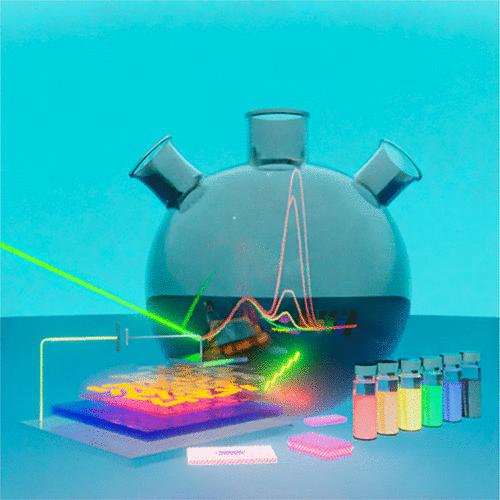当前位置:
X-MOL 学术
›
Chem. Rev.
›
论文详情
Our official English website, www.x-mol.net, welcomes your
feedback! (Note: you will need to create a separate account there.)
2D II–VI Semiconductor Nanoplatelets: From Material Synthesis to Optoelectronic Integration
Chemical Reviews ( IF 51.4 ) Pub Date : 2023-02-01 , DOI: 10.1021/acs.chemrev.2c00436 Benjamin T Diroll 1 , Burak Guzelturk 2 , Hong Po 3 , Corentin Dabard 3 , Ningyuan Fu 3 , Lina Makke 3 , Emmanuel Lhuillier 4 , Sandrine Ithurria 3
Chemical Reviews ( IF 51.4 ) Pub Date : 2023-02-01 , DOI: 10.1021/acs.chemrev.2c00436 Benjamin T Diroll 1 , Burak Guzelturk 2 , Hong Po 3 , Corentin Dabard 3 , Ningyuan Fu 3 , Lina Makke 3 , Emmanuel Lhuillier 4 , Sandrine Ithurria 3
Affiliation

|
The field of colloidal synthesis of semiconductors emerged 40 years ago and has reached a certain level of maturity thanks to the use of nanocrystals as phosphors in commercial displays. In particular, II–VI semiconductors based on cadmium, zinc, or mercury chalcogenides can now be synthesized with tailored shapes, composition by alloying, and even as nanocrystal heterostructures. Fifteen years ago, II–VI semiconductor nanoplatelets injected new ideas into this field. Indeed, despite the emergence of other promising semiconductors such as halide perovskites or 2D transition metal dichalcogenides, colloidal II–VI semiconductor nanoplatelets remain among the narrowest room-temperature emitters that can be synthesized over a wide spectral range, and they exhibit good material stability over time. Such nanoplatelets are scientifically and technologically interesting because they exhibit optical features and production advantages at the intersection of those expected from colloidal quantum dots and epitaxial quantum wells. In organic solvents, gram-scale syntheses can produce nanoparticles with the same thicknesses and optical properties without inhomogeneous broadening. In such nanoplatelets, quantum confinement is limited to one dimension, defined at the atomic scale, which allows them to be treated as quantum wells. In this review, we discuss the synthetic developments, spectroscopic properties, and applications of such nanoplatelets. Covering growth mechanisms, we explain how a thorough understanding of nanoplatelet growth has enabled the development of nanoplatelets and heterostructured nanoplatelets with multiple emission colors, spatially localized excitations, narrow emission, and high quantum yields over a wide spectral range. Moreover, nanoplatelets, with their large lateral extension and their thin short axis and low dielectric surroundings, can support one or several electron–hole pairs with large exciton binding energies. Thus, we also discuss how the relaxation processes and lifetime of the carriers and excitons are modified in nanoplatelets compared to both spherical quantum dots and epitaxial quantum wells. Finally, we explore how nanoplatelets, with their strong and narrow emission, can be considered as ideal candidates for pure-color light emitting diodes (LEDs), strong gain media for lasers, or for use in luminescent light concentrators.
中文翻译:

二维 II–VI 半导体纳米片:从材料合成到光电集成
半导体胶体合成领域出现于 40 年前,由于在商业显示器中使用纳米晶体作为荧光粉,该领域已达到一定的成熟度。特别是,基于镉、锌或汞硫属元素化物的 II-VI 半导体现在可以合成具有定制形状、合金成分,甚至纳米晶体异质结构。十五年前,II-VI 族半导体纳米片为该领域注入了新的思路。事实上,尽管出现了其他有前途的半导体,如卤化物钙钛矿或二维过渡金属二硫化物,胶体 II-VI 半导体纳米片仍然是最窄的室温发射体,可以在很宽的光谱范围内合成,并且它们表现出良好的材料稳定性时间。这种纳米片在科学和技术上很有趣,因为它们在胶体量子点和外延量子阱的交叉点上表现出光学特征和生产优势。在有机溶剂中,克级合成可以产生具有相同厚度和光学特性的纳米粒子,而不会出现不均匀展宽。在这样的纳米片中,量子限制被限制在一维,在原子尺度上定义,这使得它们可以被视为量子阱。在这篇综述中,我们讨论了此类纳米片的合成发展、光谱特性和应用。涵盖生长机制,我们解释了对纳米片生长的透彻理解如何能够开发出具有多种发射颜色的纳米片和异质结构纳米片,空间局部激发、窄发射和宽光谱范围内的高量子产率。此外,具有大横向延伸、细短轴和低介电环境的纳米片可以支持一个或多个具有大激子结合能的电子-空穴对。因此,我们还讨论了与球形量子点和外延量子阱相比,载流子和激子的弛豫过程和寿命如何在纳米片中发生变化。最后,我们探讨了具有强而窄发射的纳米片如何被视为纯色发光二极管 (LED)、激光强增益介质或用于荧光聚光器的理想候选者。凭借其大的横向延伸、细的短轴和低介电环境,可以支持一个或多个具有大激子结合能的电子-空穴对。因此,我们还讨论了与球形量子点和外延量子阱相比,载流子和激子的弛豫过程和寿命如何在纳米片中发生变化。最后,我们探讨了具有强而窄发射的纳米片如何被视为纯色发光二极管 (LED)、激光强增益介质或用于荧光聚光器的理想候选者。凭借其大的横向延伸、细的短轴和低介电环境,可以支持一个或多个具有大激子结合能的电子-空穴对。因此,我们还讨论了与球形量子点和外延量子阱相比,载流子和激子的弛豫过程和寿命如何在纳米片中发生变化。最后,我们探讨了具有强而窄发射的纳米片如何被视为纯色发光二极管 (LED)、激光强增益介质或用于荧光聚光器的理想候选者。我们还讨论了与球形量子点和外延量子阱相比,载流子和激子的弛豫过程和寿命如何在纳米片中发生变化。最后,我们探讨了具有强而窄发射的纳米片如何被视为纯色发光二极管 (LED)、激光强增益介质或用于荧光聚光器的理想候选材料。我们还讨论了与球形量子点和外延量子阱相比,载流子和激子的弛豫过程和寿命如何在纳米片中发生变化。最后,我们探讨了具有强而窄发射的纳米片如何被视为纯色发光二极管 (LED)、激光强增益介质或用于荧光聚光器的理想候选材料。
更新日期:2023-02-01
中文翻译:

二维 II–VI 半导体纳米片:从材料合成到光电集成
半导体胶体合成领域出现于 40 年前,由于在商业显示器中使用纳米晶体作为荧光粉,该领域已达到一定的成熟度。特别是,基于镉、锌或汞硫属元素化物的 II-VI 半导体现在可以合成具有定制形状、合金成分,甚至纳米晶体异质结构。十五年前,II-VI 族半导体纳米片为该领域注入了新的思路。事实上,尽管出现了其他有前途的半导体,如卤化物钙钛矿或二维过渡金属二硫化物,胶体 II-VI 半导体纳米片仍然是最窄的室温发射体,可以在很宽的光谱范围内合成,并且它们表现出良好的材料稳定性时间。这种纳米片在科学和技术上很有趣,因为它们在胶体量子点和外延量子阱的交叉点上表现出光学特征和生产优势。在有机溶剂中,克级合成可以产生具有相同厚度和光学特性的纳米粒子,而不会出现不均匀展宽。在这样的纳米片中,量子限制被限制在一维,在原子尺度上定义,这使得它们可以被视为量子阱。在这篇综述中,我们讨论了此类纳米片的合成发展、光谱特性和应用。涵盖生长机制,我们解释了对纳米片生长的透彻理解如何能够开发出具有多种发射颜色的纳米片和异质结构纳米片,空间局部激发、窄发射和宽光谱范围内的高量子产率。此外,具有大横向延伸、细短轴和低介电环境的纳米片可以支持一个或多个具有大激子结合能的电子-空穴对。因此,我们还讨论了与球形量子点和外延量子阱相比,载流子和激子的弛豫过程和寿命如何在纳米片中发生变化。最后,我们探讨了具有强而窄发射的纳米片如何被视为纯色发光二极管 (LED)、激光强增益介质或用于荧光聚光器的理想候选者。凭借其大的横向延伸、细的短轴和低介电环境,可以支持一个或多个具有大激子结合能的电子-空穴对。因此,我们还讨论了与球形量子点和外延量子阱相比,载流子和激子的弛豫过程和寿命如何在纳米片中发生变化。最后,我们探讨了具有强而窄发射的纳米片如何被视为纯色发光二极管 (LED)、激光强增益介质或用于荧光聚光器的理想候选者。凭借其大的横向延伸、细的短轴和低介电环境,可以支持一个或多个具有大激子结合能的电子-空穴对。因此,我们还讨论了与球形量子点和外延量子阱相比,载流子和激子的弛豫过程和寿命如何在纳米片中发生变化。最后,我们探讨了具有强而窄发射的纳米片如何被视为纯色发光二极管 (LED)、激光强增益介质或用于荧光聚光器的理想候选者。我们还讨论了与球形量子点和外延量子阱相比,载流子和激子的弛豫过程和寿命如何在纳米片中发生变化。最后,我们探讨了具有强而窄发射的纳米片如何被视为纯色发光二极管 (LED)、激光强增益介质或用于荧光聚光器的理想候选材料。我们还讨论了与球形量子点和外延量子阱相比,载流子和激子的弛豫过程和寿命如何在纳米片中发生变化。最后,我们探讨了具有强而窄发射的纳米片如何被视为纯色发光二极管 (LED)、激光强增益介质或用于荧光聚光器的理想候选材料。











































 京公网安备 11010802027423号
京公网安备 11010802027423号